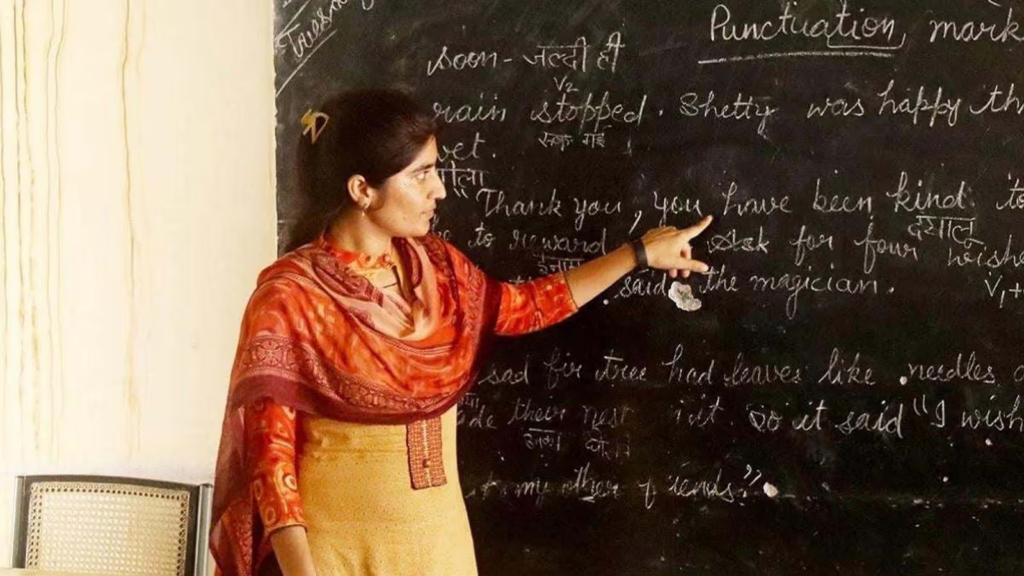India’s schooling system, one of the largest in the world, is grappling with a hidden but deeply troubling challenge — over 1 lakh schools operating with only a single teacher. According to the Ministry of Education’s latest data for the 2024–25 academic year, 1,04,000+ single-teacher schools are educating more than 33.7 lakh students.

For a country aspiring toward Viksit Bharat 2047, these numbers reflect an uncomfortable reality: millions of children are learning in severely understaffed classrooms where one teacher is expected to do the job of many.
A System Stretched Thin: 33 Lakh Students, 1 Teacher Each
The average single-teacher school serves 34 students, but beyond the numbers lies a deeper issue — how can one teacher realistically teach multiple classes, subjects, and activities simultaneously?
Many of these schools are located in rural, hilly, or tribal regions, where access, infrastructure, and resources are already limited. The lack of teachers only compounds existing inequalities in learning outcomes, especially for children who already struggle with poverty or limited academic support at home.
States with the Highest Burden
The data, originally reported by The Indian Express, reveals stark geographic differences.
Top states with the most single-teacher schools
- Andhra Pradesh — 12,912
- Uttar Pradesh — 9,508
- Jharkhand — 9,172
- Maharashtra — 8,152
- Karnataka — 7,349
Surprisingly, small regions such as Lakshadweep and Madhya Pradesh also show high numbers — 7,217 each.
In sharp contrast, Delhi has only 9 single-teacher schools, and Puducherry, Chandigarh, Ladakh, and Dadra & Nagar Haveli report zero.
States with the Highest Student Enrolment in Single-Teacher Schools
The student burden paints an equally worrying picture:
- Uttar Pradesh — 6.24 lakh students
- Jharkhand — 4.36 lakh
- West Bengal — 2.35 lakh
- Madhya Pradesh — 2.29 lakh
- Karnataka — 2.23 lakh
These numbers highlight deep systemic gaps, especially in educational access and human resource distribution.
Striking Disparities: Class Sizes That Defy Logic
One of the most surprising findings is the huge variation in average students per single-teacher school:
- Chandigarh — 1,222 students per school
- Delhi — 808 students per school
These numbers raise urgent questions about administrative categorisation and policy oversight — no single teacher can manage hundreds of students effectively.
On the other hand, remote regions like:
- Ladakh — 59 students
- Mizoram — 70 students
- Meghalaya — 73 students
have smaller class sizes, but still face the fundamental challenge of lacking a multi-teacher workforce.
A Decline, But Not a Solution
Officials noted a gradual reduction in single-teacher schools:
- 2022–23: 1,18,190 schools
- 2023–24: 1,10,971 schools
This 6% decrease is attributed to:
- school mergers,
- rationalisation of resources,
- redeployment of teachers.
But experts caution that while merging schools helps optimise manpower, it often increases:
- travel distances for children,
- dropout rates in rural areas,
- and loss of community school culture.
The decline is progress — but far from a resolution.
Government Response: Redeployments & RTE Standards
A senior Ministry of Education official noted:
“Single-teacher schools hinder the teaching-learning process. We are redeploying teachers from zero-enrolment schools to ensure optimal availability.”
States are working to meet the RTE Act’s mandated Pupil-Teacher Ratio (PTR):
- 30:1 for primary,
- 35:1 for upper primary.
Yet, meeting these numbers remains difficult in:
- tribal belts,
- coastal pockets,
- forested zones,
- and geographically isolated regions.
Why This Crisis Demands Urgent Attention
Single-teacher schools don’t just strain teachers — they compromise children’s right to quality education.
Key concerns include:
- limited individual attention for students
- combined classes across multiple grades
- low learning levels in foundational literacy and numeracy
- challenges in implementing NEP 2020
- lack of extracurricular or sports activities
- teacher burnout and absenteeism
- weakened community trust in government schools
For millions of children, this means learning gaps that follow them for life.
The Road to Viksit Bharat 2047 Runs Through Its Classrooms
If India hopes to become a fully developed nation by 2047, no child should be studying in a classroom without adequate teachers. The presence of even one more teacher can drastically change:
- attendance,
- learning outcomes,
- student motivation,
- and classroom safety.
Strengthening India’s teacher workforce is not optional — it is foundational.
As the government continues its work under NEP 2020 and RTE Act, the focus must remain on:
- attracting more qualified teachers,
- improving training and incentives,
- ensuring deployment where they are most needed,
- and building accountability around PTR compliance.
Also Read: https://thenewstudent.com/wp-admin/post.php?post=4302&action=edit
https://scoonews.com/news/beyond-the-syllabus-school-teachers-insights-on-project-based-learning/